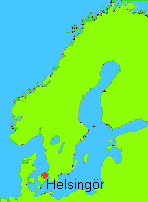Meet the Middle Ages
BackHelsingör

Helsingör was, thanks to its position at one of the entrances to the Baltic Sea, an important trading centre as early as in the 13th century. In 1423, King Erik of Pommern had Krogen Castle erected in Helsingör. He also had three monasteries built, and the town became a religious centre.
Helsingör, together with Helsingborg on the other side of the Öresund Sound, was an effective gate-way for the shipping. This was taken advantage of when a Sound Duty was introduced in 1429. The Sound Duty was a fee which every ship had to pay to the Danish Crown. In the 16th century, Krogen Castle was replaced by Kronborg Castle. The countries trading on the Baltic Sea did not like to pay duty to the Danish Crown. The Duty was one of the reasons for the endless wars between Sweden and Denmark. After the peace at Brömsebro in 1645, the customs duty was lowered and the Swedish Baltic provinces were exempt from duty.
Helsingör flourished during the 16th and 17th centuries. The wars against Sweden and the loss of Skåne led to an economic recession which deepened as an outburst of the plague hit the town in 1709-1711. Two medieval churches and Kronborg Castle remain from this time.